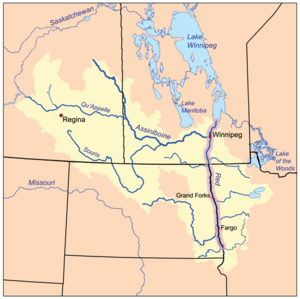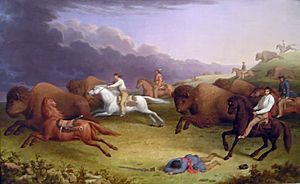Bois-Brûlés facts for kids
The Bois-Brûlés (pronounced Bwah-Broo-lay) means burnt wood in French. This name was often used for the Métis people. The Métis are a group of people with mixed Indigenous and European (often French) heritage.
The name Bois-Brûlés was mostly used for the French-speaking Métis. They lived in the Red River Colony. This colony was in the Red River valley in what is now Canada and the United States.
Contents
Early History of the Bois-Brûlés
The Bois-Brûlés were important in the early 1800s. Their leader was Cuthbert Grant. They took part in a famous event called the Battle of Seven Oaks in 1816. This battle was a conflict between the Métis and the Red River Colony.
The Song of the Bois-Brûlés
After the Battle of Seven Oaks, a Métis poet named Pierre Falcon wrote a song. It was called "Chanson de la Grenouillère" or "Falcon's Song." This song celebrated the Bois-Brûlés as winners of the battle. It became a very important song for the Métis people for many years.
Pierre Falcon also wrote another song in 1837. It was about a man named James Dickson. Dickson had a big plan to create a kingdom in California. He wanted to gather an army of Bois-Brûlés to help him.
Life on the Prairies
In 1823, a traveler named William H. Keating met some Bois-Brûlés. They were hunting buffalo near Pembina, by the Red River. Keating described their clothing. They often wore a blue coat with a hood, called a capote. They also wore moccasins and leather leggings.
William Keating wrote about their unique style:
All of them have a blue capote with a hood, which they use only in bad weather; the capote is secured round their waist by a military sash; they wear a shirt of calico or painted muslin, moccassins and leather leggings fastened round the leg by garters ornamented with beads,&c. The Bois brulés often dispense with a hat; when they have one, it is generally variegated in the Indian manner, with feathers, gilt lace, and other tawdry ornaments.
—William Keating 1824
Later Years and the Métis Name
In the late 1800s, the Bois-Brûlés became well-known again. This was during the Red River Resistance in 1869. This was a time when the Métis people stood up for their rights in the Red River area.
Over time, the name Bois-Brûlés was used less often. People started to use the name Métis more. Most of these people were descendants of French Canadian men and First Nations women.
The name Bois-Brûlés became less common after 1821. This was when two big fur trading companies, the Hudson's Bay Company and the North West Company, joined together.
Even later, some people still used the term. In 1837, a young adventurer named Martin McLeod wrote about the "Brules" in his travel journal. And as late as 1900, the famous American author Jack London used the term in one of his short stories.
See also
 In Spanish: Bois-Brûlés para niños
In Spanish: Bois-Brûlés para niños




